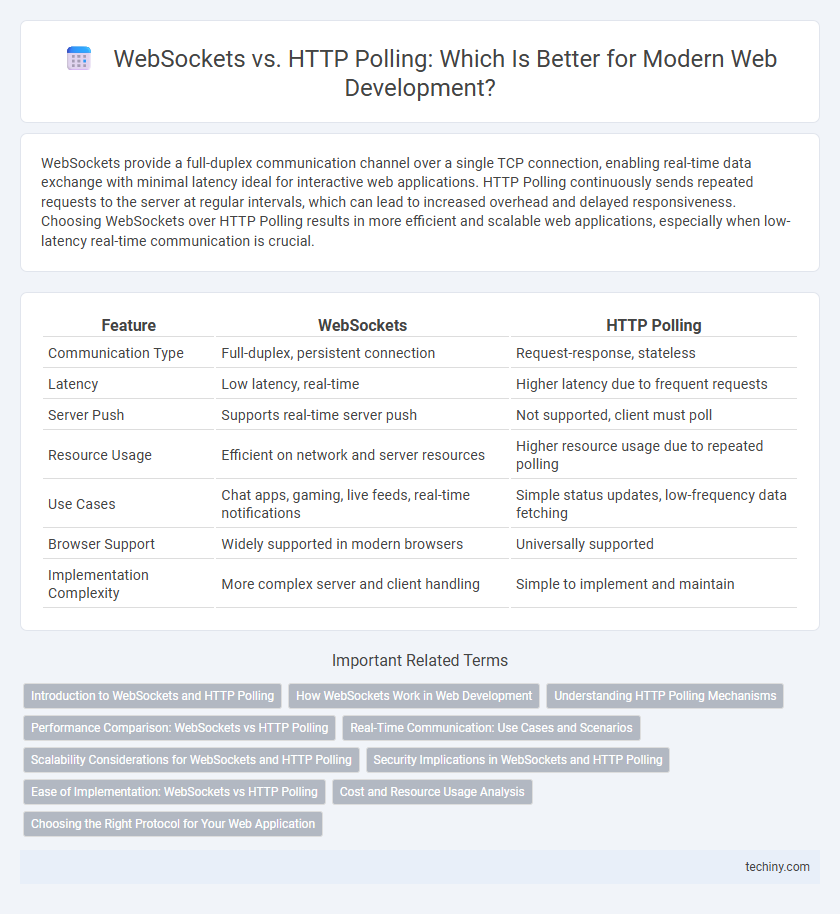WebSockets provide a full-duplex communication channel over a single TCP connection, enabling real-time data exchange with minimal latency ideal for interactive web applications. HTTP Polling continuously sends repeated requests to the server at regular intervals, which can lead to increased overhead and delayed responsiveness. Choosing WebSockets over HTTP Polling results in more efficient and scalable web applications, especially when low-latency real-time communication is crucial.
Table of Comparison
| Feature | WebSockets | HTTP Polling |
|---|---|---|
| Communication Type | Full-duplex, persistent connection | Request-response, stateless |
| Latency | Low latency, real-time | Higher latency due to frequent requests |
| Server Push | Supports real-time server push | Not supported, client must poll |
| Resource Usage | Efficient on network and server resources | Higher resource usage due to repeated polling |
| Use Cases | Chat apps, gaming, live feeds, real-time notifications | Simple status updates, low-frequency data fetching |
| Browser Support | Widely supported in modern browsers | Universally supported |
| Implementation Complexity | More complex server and client handling | Simple to implement and maintain |
Introduction to WebSockets and HTTP Polling
WebSockets provide a full-duplex communication channel over a single, long-lived TCP connection, allowing real-time interaction between clients and servers with minimal overhead. HTTP Polling repeatedly sends HTTP requests at fixed intervals to check for updates, resulting in increased latency and higher bandwidth usage compared to WebSockets. Understanding the differences in connection persistence and data transfer efficiency is crucial for optimizing web application performance.
How WebSockets Work in Web Development
WebSockets establish a persistent, full-duplex communication channel between the client and server, enabling real-time data exchange without the need for repeated HTTP requests. This protocol uses a single TCP connection that remains open, allowing servers to push updates instantly to clients, which enhances performance and reduces latency in web applications. Web development frameworks like Node.js and libraries such as Socket.IO simplify WebSocket integration, facilitating interactive features like live chat, real-time notifications, and multiplayer gaming.
Understanding HTTP Polling Mechanisms
HTTP polling is a client-initiated communication method where the browser repeatedly sends HTTP requests to the server at fixed intervals to check for updates. This mechanism can lead to increased latency and higher server load due to frequent, potentially unnecessary requests. Unlike WebSockets, HTTP polling does not maintain a persistent connection, resulting in less efficient real-time data exchange for dynamic web applications.
Performance Comparison: WebSockets vs HTTP Polling
WebSockets provide significantly lower latency and reduced network overhead compared to HTTP polling by establishing a persistent connection that allows real-time bidirectional data exchange. HTTP polling repeatedly sends new HTTP requests to the server, leading to higher bandwidth consumption and increased server load due to frequent polling intervals. Benchmark studies show WebSockets outperform HTTP polling in applications requiring rapid data updates, delivering faster response times and more efficient resource utilization.
Real-Time Communication: Use Cases and Scenarios
WebSockets provide a persistent, low-latency connection ideal for real-time applications like live chats, online gaming, and financial tickers where instant data updates are critical. HTTP polling, by repeatedly sending requests at intervals, suits simpler use cases such as status checks and notifications but often leads to higher latency and increased server load. Choosing between WebSockets and HTTP polling depends on the application's requirement for immediacy, scalability, and resource efficiency in real-time communication scenarios.
Scalability Considerations for WebSockets and HTTP Polling
WebSockets offer superior scalability compared to HTTP polling by maintaining a persistent, full-duplex communication channel, significantly reducing server resource consumption and network overhead. HTTP polling requires frequent client-initiated requests, leading to increased latency and higher server load as the number of clients grows. Efficient handling of concurrent WebSocket connections through event-driven architectures enables scalability in real-time web applications, whereas HTTP polling faces challenges in scaling due to constant connection establishment and teardown.
Security Implications in WebSockets and HTTP Polling
WebSockets establish a persistent, full-duplex communication channel, which can expose applications to increased risks such as cross-site WebSocket hijacking and man-in-the-middle attacks if proper security measures like TLS encryption and origin validation are not implemented. HTTP polling, relying on repeated client-server requests, inherently limits continuous exposure but can still be vulnerable to session hijacking and denial-of-service attacks without secure authentication and rate limiting. Implementing strict Content Security Policies (CSP), robust token-based authentication, and encrypted connections is critical to mitigating security threats in both WebSockets and HTTP polling.
Ease of Implementation: WebSockets vs HTTP Polling
WebSockets offer a more streamlined implementation for real-time communication by establishing a persistent connection, reducing the need for continuous requests and responses typical in HTTP polling. HTTP polling, while simpler to implement using standard HTTP protocols and widely supported, requires repeated client-server interactions that can increase server load and latency. Developers often choose WebSockets for efficient, event-driven applications despite the slightly steeper initial setup compared to the straightforward but less scalable HTTP polling method.
Cost and Resource Usage Analysis
WebSockets establish a persistent, full-duplex communication channel between client and server, significantly reducing overhead by eliminating repetitive HTTP request headers inherent in HTTP polling. HTTP polling continuously sends multiple HTTP requests at set intervals, leading to increased bandwidth usage, higher latency, and greater CPU load on both client and server, resulting in elevated operational costs. WebSockets optimize resource usage, lowering server CPU cycles and network bandwidth consumption, making them more cost-effective for applications requiring real-time data transfer or frequent updates.
Choosing the Right Protocol for Your Web Application
WebSockets provide a full-duplex communication channel ideal for real-time applications like chat apps, gaming, and live updates, offering low latency and reduced overhead compared to HTTP polling. HTTP polling repeatedly sends requests to check for updates, causing higher server load and increased latency, making it less efficient for scenarios requiring instant data exchange. Selecting WebSockets is optimal when your web application demands continuous, bidirectional communication, while HTTP polling suits simpler, infrequent update needs with less complexity.
WebSockets vs HTTP Polling Infographic

 techiny.com
techiny.com